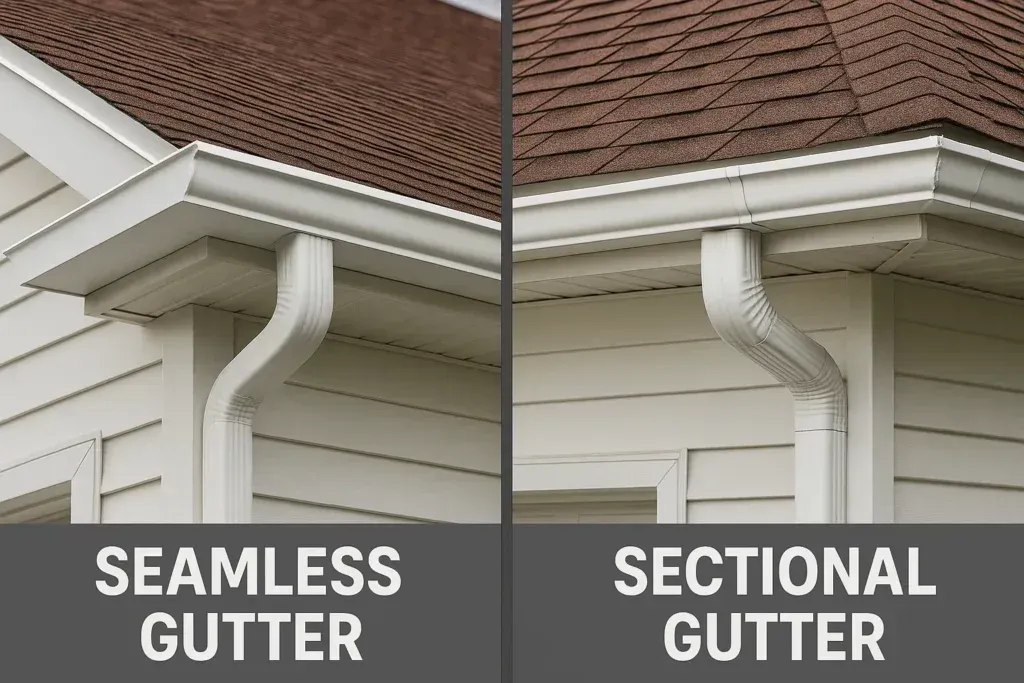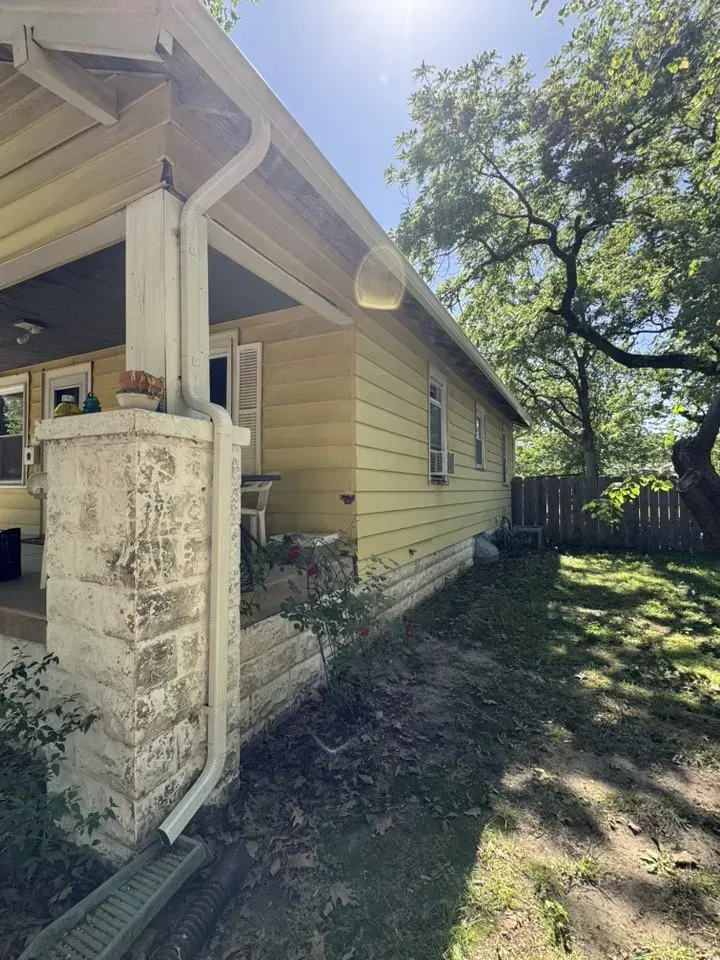The Complete Guide to Gutter Types: Choosing the Right Style for Your Home
Gutters are really important for your home, even though most people don’t think about them much. These metal or plastic channels catch rainwater from your roof and move it away from your house. Without good gutters, water can damage your foundation, basement, and the outside of your home.
There are several different types of gutters you can choose from. Some look fancy and decorative, while others are simple and practical. The type you pick depends on what your house looks like, how much rain you get, and how much money you want to spend.
Whether you’re building a new house or replacing old gutters, it’s important to know your options. The right gutters will protect your home and make it look good too.
In this guide, we’ll show you the most popular types of gutters and help you figure out which one is best for your home.

Clogged or damaged gutters can cause expensive water damage to your home.
Main Gutter Profile Types
K-Style (Ogee) Gutters:
K-style gutters are the most popular choice for homes today. They have a flat bottom and a decorative front that looks like crown molding. These gutters can hold more water than other types, which makes them great for heavy rain. They’re also cheaper than most other options and easy to find at home stores. K-style gutters work well with most house styles.
Half-Round Gutters
Half-round gutters look like a pipe cut in half. They have a simple, curved shape that’s been used for hundreds of years. You’ll often see them on older or historic homes. While they look classic and beautiful, they don’t hold as much water as K-style gutters. They also cost more and can be harder to find. But if you want a traditional look, half-round gutters are perfect.
Box Gutters
Box gutters are built right into your roof, so you can’t see them from the ground. They’re hidden behind a piece of wood or metal. These gutters give your house a very clean, modern look. However, they’re harder to clean and fix because they’re built in. If they get clogged or break, it can be expensive to repair them.
Fascia Gutters
Fascia gutters replace the board under your roof edge. They give your house a smooth, finished look because there’s no gap between the gutter and your roof. These gutters need special installation and work best on certain types of houses. They’re not as common as other types, but they create a very neat appearance.
Here’s the Sizing Considerations section in simple language:
Sizing Considerations
Standard Sizes (5-inch vs 6-inch)
Most gutters come in two main sizes: 5-inch and 6-inch. The size refers to how wide the gutter opening is. Five-inch gutters are the most common and work fine for most homes. Six-inch gutters are bigger and can handle more water, but they also cost more.
How to Determine the Right Size for Your Home
The size you need depends on two main things: how big your roof is and how much rain you get. Bigger roofs collect more water, so they need bigger gutters. If you live in an area with heavy rains or storms, you should also consider larger gutters.
Here’s a simple rule: if your roof is under 5,500 square feet, 5-inch gutters usually work fine. If your roof is bigger than that, or if you get lots of heavy rain, 6-inch gutters are better.
When to Upgrade to Larger Gutters
You should think about bigger gutters if:
- Water spills over your current gutters during heavy rain
- You have a steep roof that sends water down fast
- Your roof has large sections that drain into one spot
- You live somewhere with frequent heavy storms
- Your downspouts can’t keep up with the water flow
Remember, bigger gutters need bigger downspouts too. If you upgrade your gutters, make sure your downspouts can handle the extra water.
[Here's some more info on choosing the right gutter size for your home]
Seamless vs. Sectional
Sectional Gutters
Sectional gutters come in pieces that connect together. You can buy them at home stores and install them yourself. They cost less upfront but have joints that can leak over time. These joints need regular maintenance to prevent problems.
Seamless Gutters
Seamless gutters are made in one long piece with no joints. A professional brings a special machine to your house to make them the exact length needed. They cost more but rarely leak and need less maintenance.
Which Should You Choose?
Seamless gutters work better and last longer, but sectional gutters are cheaper and easier to replace yourself. Most homeowners choose seamless for the peace of mind.
[For a detailed comparison of seamless vs. sectional gutters, including costs and installation tips, check out our guide to Seamless vs Sectional Gutters.]

Choosing the Right Type
Matching Your Home’s Style
Your gutters should match how your house looks. Traditional homes with lots of detail look great with half-round or decorative K-style gutters. Modern homes with clean lines work well with box gutters or simple K-style gutters. Colonial and historic homes often use half-round gutters to keep their classic look. Ranch and contemporary homes usually look best with K-style gutters.
Climate Considerations
Where you live affects which gutters work best. If you get heavy rain or snow, choose larger gutters that can handle more water. In areas with lots of ice, steel gutters work better than vinyl because they won’t crack. Hot, sunny places can make vinyl gutters fade and become brittle, so aluminum or steel might be better choices.
Budget Factors
Gutter costs vary a lot depending on what you choose. Vinyl gutters are the cheapest but don’t last as long. Aluminum costs more but lasts longer and looks better. Copper and zinc cost the most but can last 50+ years. Remember to think about long-term costs, not just the price upfront. Sometimes spending more now saves money later.
Maintenance Preferences
Think about how much work you want to do to keep your gutters clean. Seamless gutters need less maintenance than sectional ones. Some materials like copper and zinc need almost no care once installed. Box gutters are harder to clean because they’re built into your roof. If you don’t want to climb ladders often, choose gutters that are easy to maintain from the ground.
Installation and Maintenance Tips
Professional vs. DIY Installation
Some gutter jobs you can do yourself, and others need a professional. Sectional vinyl or aluminum gutters from the hardware store are easier to install on your own. You’ll need basic tools and a sturdy ladder. However, seamless gutters always need a professional because they require special equipment. Copper, steel, and box gutters also need professional installation because they’re harder to work with and need special skills.
[For detailed installation tips, check out our DIY installation guide]
Common Maintenance Needs by Gutter Type
All gutters need cleaning at least twice a year to remove leaves and debris. K-style gutters are easy to clean because they have a wide opening. Half-round gutters are also simple to maintain. Box gutters are the hardest to clean because you can’t see inside them easily. Sectional gutters need extra attention at the joints where pieces connect. Check these spots for leaks every year. Seamless gutters mainly just need cleaning and checking for small dents or damage.
Warning Signs You Need New Gutters
Replace your gutters if you see these problems:
- Cracks or holes that keep getting bigger
- Rust spots that won’t go away
- Gutters pulling away from your house
- Water spilling over the sides during normal rain
- Big dents that change the gutter’s shape
- Peeling paint that keeps coming back
- Water stains on your siding under the gutters
- Gutters that sag or don’t slope toward downspouts
If you see several of these problems, it’s usually cheaper to replace your gutters than to keep fixing them.
[For a detailed guide on gutter warning signs, especially after a storm, check out our Top 5 Signs Your Gutters Were Damaged by Storms]
Cost Breakdown
Typical Gutter Prices by Material
Gutter installation costs vary a lot depending on what you choose. Here are typical prices per foot:
Vinyl gutters are the cheapest at $3-7 per foot. These plastic gutters work well for tight budgets but don’t last as long as other materials.
Aluminum gutters cost $6-12 per foot and are the most popular choice. They offer good value for the price and work with most homes.
Steel gutters run $8-16 per foot. These strong gutters cost more but handle heavy snow and ice better than other types.
Copper gutters are the most expensive at $15-30 per foot. While costly, copper gutter systems can last 50+ years and look beautiful.
Half-round vs K-style gutter costs are usually similar, but half-round gutters may cost slightly more because they’re less common.
[Here's a more in-depth rundown of the different gutter material options]
What Affects Your Total Gutter Cost
Several things can make your gutter replacement more or less expensive:
- House size: Bigger homes need more gutters, which costs more
- Roof height: Two-story homes cost more because installation is harder
- Gutter guards: Adding leaf guards increases costs by $3-8 per foot
- Downspout needs: More downspouts mean higher costs
- Labor costs: Professional installation adds $3-5 per foot
- Seamless vs sectional: Seamless gutters cost more upfront but save money long-term
- Location: Gutter prices vary by area and local labor costs
Most homeowners spend $1,200-3,000 for complete gutter installation on an average-sized house.
[Are you considering seamless gutters? Take a look at
seamless gutter costs in Wichita]

Conclusion
Choosing the right gutters for your home doesn’t have to be complicated. Start by thinking about your house style, local weather, and budget. K-style aluminum gutters work well for most homes and offer the best value. If you want a classic look, half-round gutters are beautiful but cost more. For low maintenance, consider seamless gutters over sectional ones.
Remember that good gutters protect your home’s foundation, siding, and landscaping from water damage. While it might be tempting to choose the cheapest option, investing in quality gutters and professional installation can save you money in the long run.
Take time to get quotes from several contractors and ask about warranties. With the right gutter system, you’ll have peace of mind knowing your home is protected for years to come.
Ready to get started? Contact us (316) 350-7115 for free estimates and find the perfect gutter solution for your home, or see our
gutter installation services in Wichita KS
